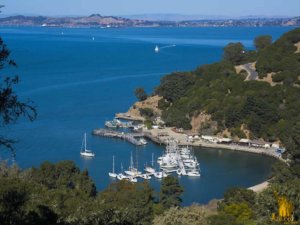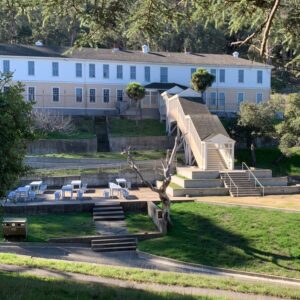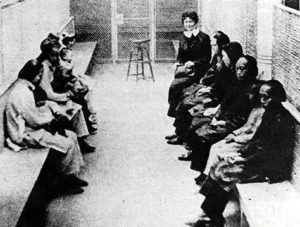Exploring the Rich History of Angel Island State Park: A Journey Through Time for Hikers

The Origins of Angel Island: How It Got Its Name
Angel Island’s history dates back centuries, beginning with its name. In August of 1775, Spanish naval officer Lt. Juan Manuel de Ayala sailed into San Francisco Bay and anchored his ship in what is now Ayala Cove. His mission was to map the bay for future Spanish expeditions, and in doing so, he named the island “Isla de Los Angeles,” after the Catholic feast day closest to his arrival. This name would eventually be shortened to “Angel Island,” and today, the cove where Ayala anchored his ship remains one of the island’s most picturesque and popular spots for visitors.
A Tapestry of Uses: From Indigenous Peoples to Immigrants
Before European explorers arrived, the island was used as hunting and gathering grounds by indigenous peoples for thousands of years. As European ships began to arrive, Angel Island served as a key resource, providing fresh water and timber to vessels in need. During the Mexican era, cattle ranching became prominent on the island, and by the 19th century, the U.S. military had established installations there.
One of the most notable chapters in Angel Island’s history, however, is its role in American immigration. From 1910 to 1940, the island housed the Angel Island Immigration Station, a facility where hundreds of thousands of immigrants—predominantly from Asia—were processed as they entered the United States. Known as “the Ellis Island of the West Coast,” Angel Island’s Immigration Station was marked by harsh conditions and strict interrogations. Many immigrants were detained for months, sometimes even years, before being allowed to enter the country, and in some cases, they were deported back to their homelands. The remnants of this immigration station still stand on the island today, offering a poignant glimpse into the challenges faced by those seeking new lives in America.
A Hiker’s Guide to Angel Island’s Historical Landmarks
Hikers visiting Angel Island have the unique opportunity to not only enjoy spectacular views of the Bay Area but also to explore the island’s rich historical landmarks along the way. Several well-preserved structures from the island’s past are accessible via hiking trails, each telling a different part of its story.

The immigration station is perhaps the most historically significant site on the island. Located on the island’s northeast side, it’s accessible via the Perimeter Road, a relatively easy hike that offers stunning views of the bay and the surrounding islands. The station itself has been partially restored, and the Angel Island Immigration Museum provides insightful exhibits about the lives of the immigrants who passed through. Hikers can reflect on the difficult experiences of those who were detained here while appreciating the beauty of the island’s serene surroundings.
2. Fort McDowell:
As you continue your hike, make your way to Fort McDowell on the eastern side of the island. During World War II, this area served as a U.S. Army post where soldiers were processed for deployment to the Pacific. The island also functioned as a temporary detention center for enemy aliens and prisoners of war, including
Angel Island State Park: A Historical Gem of the Bay – From Spanish Exploration to WWII Camps
Angel Island, often celebrated for its breathtaking views and hiking trails, holds a profound historical significance that spans centuries. From its early encounters with Spanish explorers to its strategic importance during the Civil War and World War II, this island has witnessed pivotal moments in American and global history. Today, hikers visiting Angel Island can walk through time, exploring its military installations, immigration station, and natural beauty. This post delves deeper into some of Angel Island’s lesser-known historical roles, including its involvement during the Civil War and World War II, as well as its early use by the Spanish.
Early Spanish Exploration: Mapping the Bay and Isla de Los Angeles
The first recorded European arrival at Angel Island occurred in 1775 when Spanish naval officer Lt. Juan Manuel de Ayala sailed into what is now San Francisco Bay. His mission was to chart the unexplored waters of the bay, and in doing so, he anchored his ship, San Carlos, in a cove on the northern side of the island, which is now called Ayala Cove in his honor. Ayala named the island “Isla de Los Angeles,” in reference to a nearby Catholic feast day. Over time, the name was shortened to Angel Island, which endures to this day.
Ayala’s work was crucial for future navigators and helped lay the foundation for Spain’s exploration and colonization of California. However, Ayala’s visit to the island was brief, and the island itself would not see major development by European settlers until much later. The island remained a quiet spot, used primarily by indigenous populations and later by Mexican ranchers for cattle grazing.
Angel Island’s Role in the Civil War: Defending the Bay

Camp Reynolds was established in 1863, during the height of the Civil War, and housed Union soldiers who were tasked with defending the Bay Area. While no direct military conflict occurred on the island, Camp Reynolds played a key role in maintaining Union presence and readiness on the West Coast. The soldiers stationed there also served as a backup force in case of Native American uprisings in the western territories, as well as maintaining order during labor strikes and civil unrest in nearby San Francisco.
Today, the remnants of Camp Reynolds still stand, offering visitors a glimpse into the life of Civil War-era soldiers. Hikers can explore the officers’ quarters, barracks, and other buildings that have been preserved, giving them a sense of the military lifestyle on the island. These buildings, nestled within the island’s natural surroundings, create a striking contrast between the beauty of the landscape and the militaristic purpose the island once served.
World War II: Angel Island’s Military Hub and POW Camps

Fort McDowell, located on the island’s eastern shore, was the main military installation during this period. Originally built in the late 19th century, Fort McDowell was repurposed during both World Wars to process soldiers being deployed to the Pacific theater. During World War II, tens of thousands of troops passed through Fort McDowell before being shipped to battlefronts in the Pacific. Soldiers stationed at Fort McDowell trained, prepared, and awaited deployment, often spending weeks or months on the island before embarking on their assignments.
In addition to its role as a processing center, Angel Island also served as a temporary detention site for POWs, including both Japanese and German prisoners. These prisoners of war were housed on the island while they awaited further transport or repatriation. While conditions for POWs on Angel Island were reportedly more humane than at many other camps, it remains a somber reminder of the consequences of war.
During World War II, Angel Island also functioned as a detention site for “enemy aliens”—people of Japanese, German, and Italian descent living in the United States who were considered potential security threats due to their national origins. Many of these individuals were U.S. citizens or long-time residents, and their detention is a stark reminder of the prejudice and suspicion that war can foster.
By the end of World War II, the island had hosted more than 15,000 soldiers and their families, many of whom were housed in military barracks scattered across the island. These barracks and buildings still stand today, giving visitors a sense of the military’s expansive presence on the island during this turbulent time in history.
Post-War Decommissioning and Preservation
After World War II, Angel Island’s role as a military hub came to an end. By 1946, the island was officially decommissioned as a military and immigration station. Fort McDowell and other military installations were abandoned, and the island’s future shifted toward conservation and historical preservation.
In the early 1960s, Angel Island became part of the California State Park system, ensuring that its natural beauty and historical significance would be preserved for generations to come. Today, Angel Island State Park is not only a destination for hikers and outdoor enthusiasts but also a living museum where visitors can reflect on the island’s multifaceted past.
Hiking Through History: How to Explore Angel Island’s Military and Historical Sites
For hikers looking to experience Angel Island’s historical legacy firsthand, several trails lead to key historical landmarks. Here are some recommended hikes:
- Perimeter Road: This 5-mile loop is a great way to explore many of the island’s historical sites, including the Angel Island Immigration Station, Camp Reynolds, and Fort McDowell. The trail is relatively easy and offers panoramic views of the San Francisco skyline, Golden Gate Bridge, and Marin Headlands.
- Fort McDowell: Accessible via the Perimeter Road, Fort McDowell’s military barracks and other structures remain intact, giving visitors a sense of the island’s wartime past. Guided tours are available to provide deeper insights into the site’s historical importance.
- Camp Reynolds: Located on the western side of the island, Camp Reynolds offers a fascinating look at the island’s Civil War-era military history. Hikers can explore the preserved officers’ quarters and barracks, as well as enjoy scenic views of the surrounding bay.
- Sunset Trail to Mount Livermore: For those seeking a more challenging hike, the Sunset Trail leads to the summit of Mount Livermore, the highest point on the island. Along the way, you’ll pass Camp Reynolds and be rewarded with stunning 360-degree views at the top.
Conclusion: Angel Island’s Enduring Legacy
Angel Island is more than just a recreational destination—it’s a place where history comes alive. From its early days as a Spanish outpost, through its military use during the Civil War and World War II, to its pivotal role in American immigration, the island has played an integral part in shaping the history of the Bay Area and the United States. Today, visitors can experience this history firsthand, hiking along the trails that wind through the island’s storied past while enjoying its stunning natural landscapes.
Whether you’re drawn to the island for its beauty, its historical landmarks, or a bit of both, Angel Island is a must-visit destination for anyone interested in the intersection of nature and history. Charter a yacht for a trip to Angel Island, hiking and picnic on the Bay.
